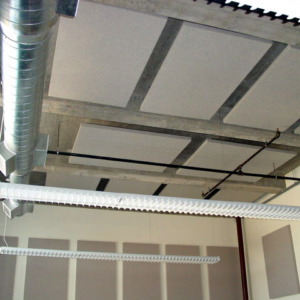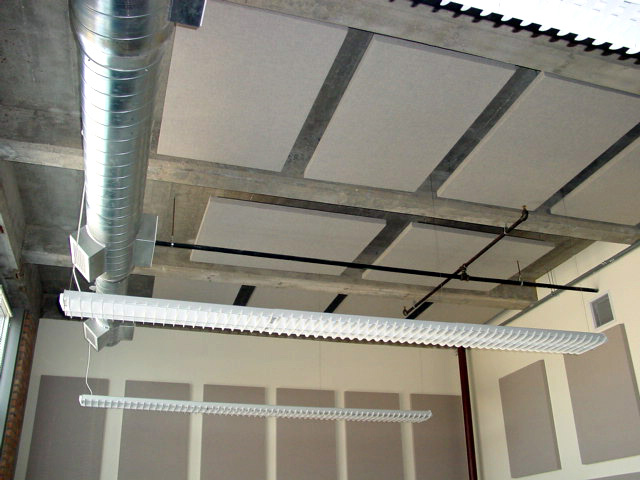Commercial Acoustics recently treated a small art museum in the city of St. Petersburg, Florida. The facility was moving from bamboo flooring to polished concrete, and the facility manager had concern for an increase in noise level (for a room that was already relatively loud). They host parties and gatherings as well, which leads to elevated speech and reverberation in the space.
Acoustic Treatment for Museums
Since artwork is on all of the walls, we needed to focus our acoustical treatment on the ceilings above. Acoustical Ceiling Clouds are an effective and aesthetic solution to absorbing unwanted noise in your enclosed space. While they may be more expensive than acoustical panels, they are also more flexible in their application – they may be hung along ceilings and exposed joists, up and out of the way.
The museum rooms had a moderate volume, and the measured reverberation time in the space was approximately 1.6 seconds prior to the floor retrofit. We calculated that the estimated reverb time would increase to 1.8 seconds with the concrete floor. Therefore, 2 moderate-sized clouds (4’x4’) were suggested for each room to bring the reverb back to the 1.4 second range. While still longer than preferred, the treatment would greatly reduce unwanted noise buildup during events and also make speech intelligibility more pleasant during smaller viewings.
We applied the 6 (total) ceiling clouds in a single morning, and the white light selected blended well with the white ceilings above. Overall, the project cost a total of approximately $3,000 and the lead time on the clouds was only a few weeks.
Acoustics of Modern and Old Museums
A study done on museum acoustics in 2013 analyzed the acoustical properties of modern museums versus that of new museums. In the study, two museums were tested – one “Old” and one “New”.

The results showed that “modern” museums tend to have poor acoustics due to the excessive use of hard finished such as marble and tile floors, the high ceilings, and large volume spaces. The echo in these modern museums is then made worse by the large number of people who congregate in one room at any time.
“Old” museums don’t have as much echo because of how they were typically designed. The room sizes weren’t as large, and they tended to have lower ceilings, which is a factor that can have a large impact on reverb time in a space. Also, many of these older museums have some furniture, and even carpet to act as absorbers.

Museum Acoustics – Conclusion
As we’ve learned from the 2013 study, as well as the small art museum located in St. Pete, FL, modern museums tend to have poor acoustics compared to older museums, although neither seem to meet target reverb time. For any echo and reverb issues in your museum or event space project, contact Commercial Acoustics for acoustic treatment options such as our Ekko Eraser Acoustic Ceiling Clouds.



